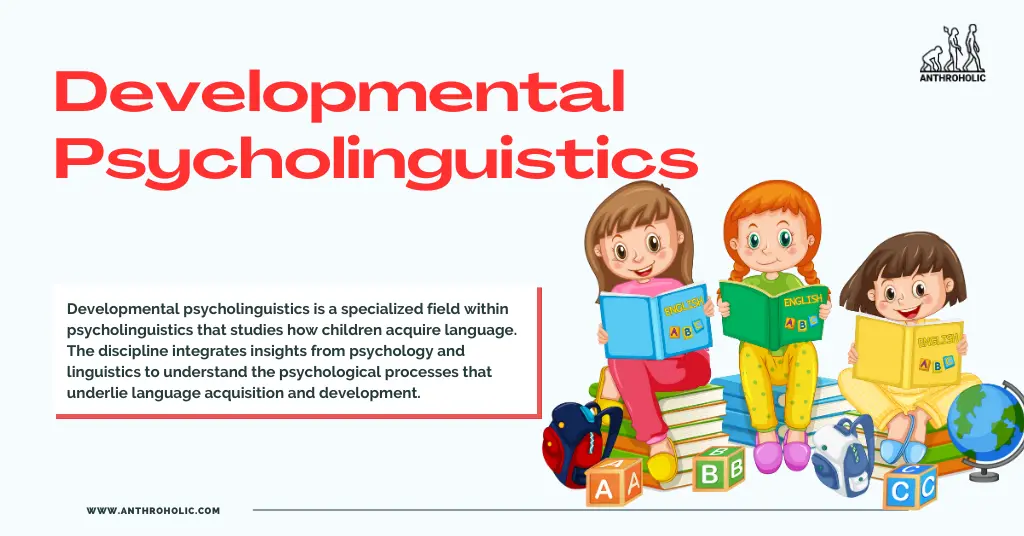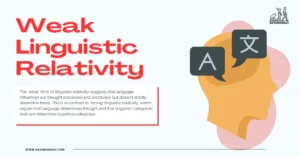AI Answer Evaluation Platform Live Now. Try Free Answer Evaluation Now
Developmental Psycholinguistics
Developmental psycholinguistics is a specialized field within psycholinguistics that studies how children acquire language. The discipline integrates insights from psychology and linguistics to understand the psychological processes that underlie language acquisition and development [1].

Stages of Language Development
Children typically go through several stages in their language development journey. These include:
- Pre-linguistic Stage (0-12 months): This stage encompasses the child’s early communicative behaviors before words emerge. Children experiment with sounds and intonation, resulting in coos, babbles, and gestures.
- One-word Stage (12-24 months): Here, children begin to utter single words, each representing an entire sentence’s worth of meaning. These first words often include common objects, family members, or actions.
- Two-word Stage (24-30 months): Children start combining two words, developing basic syntax, and showing an understanding of word order.
- Multi-word Stage (30 months onwards): This stage sees children using increasingly complex sentences, showing a grasp of grammar rules, and rapidly expanding their vocabulary.
Table 1: Stages of Language Development
| Stage | Age Range | Key Characteristics |
|---|---|---|
| Pre-linguistic | 0-12 months | Cooing, babbling, gestures |
| One-word | 12-24 months | Single word utterances |
| Two-word | 24-30 months | Two-word combinations |
| Multi-word | 30 months+ | Complex sentences |
Key Concepts in Developmental Psycholinguistics
There are several crucial concepts that researchers often emphasize in the field of developmental psycholinguistics:
- Critical Period Hypothesis: This hypothesis suggests a specific window during childhood when language acquisition occurs most efficiently. After this period, language learning becomes significantly more challenging [2].
- Language Acquisition Device (LAD): Proposed by Noam Chomsky, LAD is an innate mechanism in the brain that predisposes children to acquire language [3].
- Social Interactionist Theory: This theory underscores the importance of social interaction in language development. It posits that children learn language through their interactions with caregivers and their social environment [4].
Methods of Studying Language Development
Researchers employ various methods to study language development, such as:
- Longitudinal Studies: Here, researchers follow the same group of children over an extended period to observe changes and development in their language skills [5].
- Cross-sectional Studies: In these studies, researchers compare different age groups at the same time to understand developmental differences [6].
- Experimental Methods: These methods involve controlled experiments to understand specific aspects of language acquisition, like word recognition or sentence comprehension [7].
Challenges in Language Development
While most children naturally acquire language, some experience difficulties, such as:
- Language Delays: Some children may show slower language development compared to their peers, affecting their communication skills [8].
- Specific Language Impairment (SLI): SLI refers to a condition where a child struggles with language acquisition in the absence of any other developmental delays or hearing impairments [9].
- Autism Spectrum Disorders (ASD): Children with ASD often exhibit unique language development patterns, with some showing advanced vocabulary but struggling with pragmatic aspects of language [10].
Conclusion
Developmental psycholinguistics provides valuable insights into how language acquisition unfolds and the factors that can affect this process. By understanding this, researchers, educators, and clinicians can better support children who might struggle with language development, ultimately helping them communicate more effectively.
References
[1] Bishop, D. V. M. (2014). Uncommon Understanding: Development and Disorders of Language Comprehension in Children. Psychology Press.
[2] Lenneberg, E. (1967). Biological Foundations of Language. Wiley.
[3] Chomsky, N. (1965). Aspects of the Theory of Syntax. MIT Press.
[4] Vygotsky, L. S. (1978). Mind in Society: The Development of Higher Psychological Processes. Harvard University Press.
[5] Bates, E., & Goodman, J. C. (1999). On the Emergence of Grammar from the Lexicon. In B. MacWhinney (Ed.), The Emergence of Language. Lawrence Erlbaum Associates.
[6] Slobin, D. I. (1973). Cognitive prerequisites for the development of grammar. Studies of Child Language Development, 1, 175-208.
[7] Fernald, A., & McRoberts, G. W. (1996). Prosodic bootstrapping: A critical analysis of the argument and the evidence. In J. L. Morgan & K. Demuth (Eds.), Signal to syntax: Bootstrapping from speech to grammar in early acquisition (pp. 365–388). Lawrence Erlbaum Associates.
[8] Rescorla, L. (2005). Age 17 Language and Reading Outcomes in Late-Talking Toddlers: Support for a Dimensional Perspective on Language Delay. Journal of Speech, Language, and Hearing Research, 48, 16-30.
[9] Leonard, L. B. (2014). Children with Specific Language Impairment (2nd ed.). MIT Press.
[10] Tager-Flusberg, H., & Kasari, C. (2013). Minimally Verbal School-Aged Children with Autism Spectrum Disorder: The Neglected End of the Spectrum. Autism Research, 6, 468-478.




